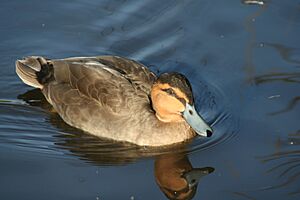Philippine duck facts for kids
Quick facts for kids Philippine duck |
|
|---|---|
 |
|
| Conservation status | |
| Scientific classification | |
| Genus: |
Anas
|
| Species: |
luzonica
|
The Philippine duck (Anas luzonica) is a large dabbling duck found only in the Philippines. It's sometimes called papan by local people. These ducks love to eat shrimp, fish, insects, and plants. You can find them in many different wet places like marshes and lakes.
Contents
What Kind of Duck Is It?
The Philippine duck is a type of dabbling duck. This means it feeds by tipping its body forward in the water, with its tail up, to reach food just below the surface. It belongs to a group of ducks called Anas. This duck is special because it's the only one of its kind, meaning it has no different types or "subspecies."
Its scientific name, Anas luzonica, comes from two parts:
- Anas is the Latin word for 'duck'.
- luzonica refers to Luzon, a large island in the Philippines.
What Does It Look Like?
The Philippine duck is a big duck that's easy to spot. It has a dark cap on its head, a dark stripe through its eye, and a dark patch on the back of its neck. The rest of its head and neck are a warm, reddish-brown color, like cinnamon.
Its body is mostly greyish-brown. When it flies, you can see a bright green patch on its wings called a speculum. Its legs are greyish-brown, and its bill (beak) is a cool bluish-grey. Girl ducks are a little smaller than boy ducks, but they look very similar.
Where Do They Live?
Philippine ducks live all over the main islands of the Philippines, and even on some smaller islands. However, since the 1980s, most sightings have been on the islands of Luzon and Mindanao. Sometimes, a few brave ducks fly very far and have been seen in places like Okinawa (Japan) and Taiwan.
These ducks can live in many different wet areas. But they especially like shallow freshwater marshes, which are like grassy wetlands.
Why Are They in Danger?
The Philippine duck is listed as a vulnerable species by the IUCN Red List. This means their numbers are getting low, and they could be in danger of disappearing if we don't help them. Experts believe there are only about 3,300 to 6,700 adult ducks left.
Their population has dropped a lot since the 1970s for two main reasons:
- Hunting: Many ducks were hunted, especially in the 1960s to late 1980s.
- Habitat Loss: The places where they live are disappearing. This happens when wetlands are drained for farms or buildings, when aquaculture (fish farming) takes over, or when mangrove forests are destroyed.
Good news! These ducks live in several protected areas in the Philippines. Some of these places include:
- Manleluag Spring Protected Landscape
- Mounts Iglit-Baco National Park
- Naujan Lake National Park
- Bataan National Park
- Northern Sierra Madre Natural Park
- Olango Island, which is a special wetland recognized internationally.
Even in protected areas, it can be hard to stop all hunting, but efforts are being made to keep these amazing ducks safe.


